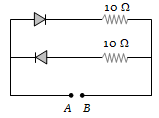Which of the following has negative temperature coefficient of resistance
(1) Copper
(2) Aluminium
(3) Iron
(4) Germanium
(1) Copper
(3) Iron
The energy gap of silicon is 1.14 eV. The maximum wavelength at which silicon will begin absorbing energy is
(1) 10888 Å
(2) 1088.8 Å
(3) 108.88 Å
(4) 10.888 Å
Which of the energy band diagrams shown in the figure corresponds to that of a semiconductor?
| 1. |  |
2. |  |
| 3. |  |
4. |  |
The energy band diagrams for three semiconductor samples of silicon are as shown. We can then assert that-
1. Sample X is undoped while samples Y and Z have been doped with a third group and a fifth group impurity respectively
2. Sample X is undoped while both samples Y and Z have been doped with a fifth group impurity
3. Sample X has been doped with equal amounts of third and fifth group impurities while samples Y and Z are undoped
4. Sample X is undoped while samples Y and Z have been doped with a fifth group and a third group impurity respectively
The temperature (T) dependence of resistivity () of a semiconductor is represented by
In the half-wave rectifier circuit shown. Which one of the following wave forms is true for , the output across C and D?
A full-wave rectifier circuit along with the input and output voltages is shown in the figure.
The contribution to the output voltage from diode – 2 is :
(1) A, C
(2) B, D
(3) B, C
(4) A, D
The i-V characteristic of a P-N junction diode is shown below. The approximate dynamic resistance of the P-N junction when a forward bias of 2 volt is applied
(1) 1
(2) 0.25
(3) 0.5
(4) 5
A 2V battery is connected across the points A and B as shown in the figure given below. Assuming that the resistance of each diode is zero in forward bias and infinity in reverse bias, the current supplied by the battery when its positive terminal is connected to A is
(a) 0.2 A
(b) 0.4 A
(c) Zero
(d) 0.1 A
In the circuit given below, V(t) is the sinusoidal voltage source, voltage drop (t) across the resistance R is
(a) Is half wave rectified
(b) Is full wave rectified
(c) Has the same peak value in the positive and negative half cycles
(d) Has different peak values during positive and negative half cycle













